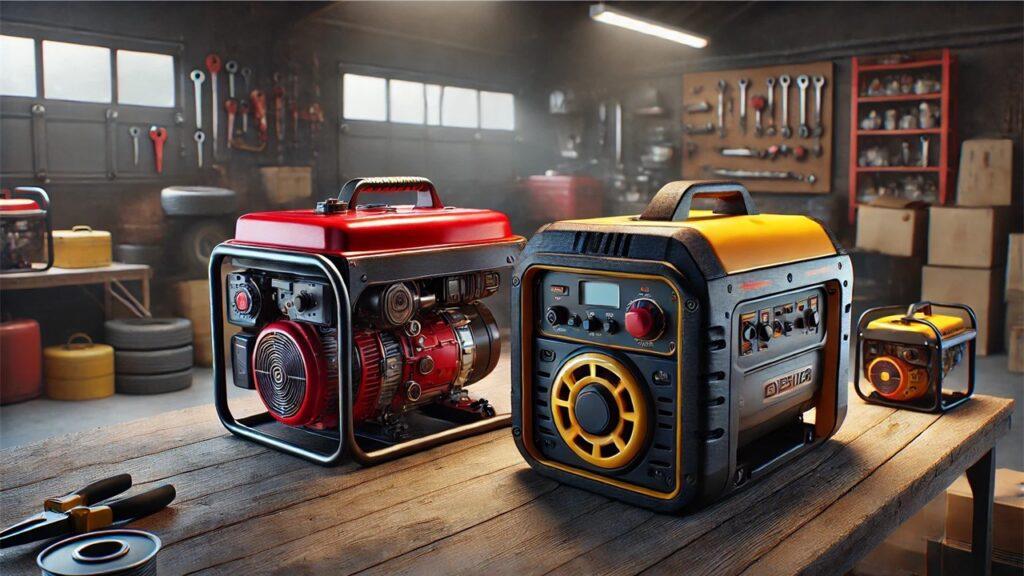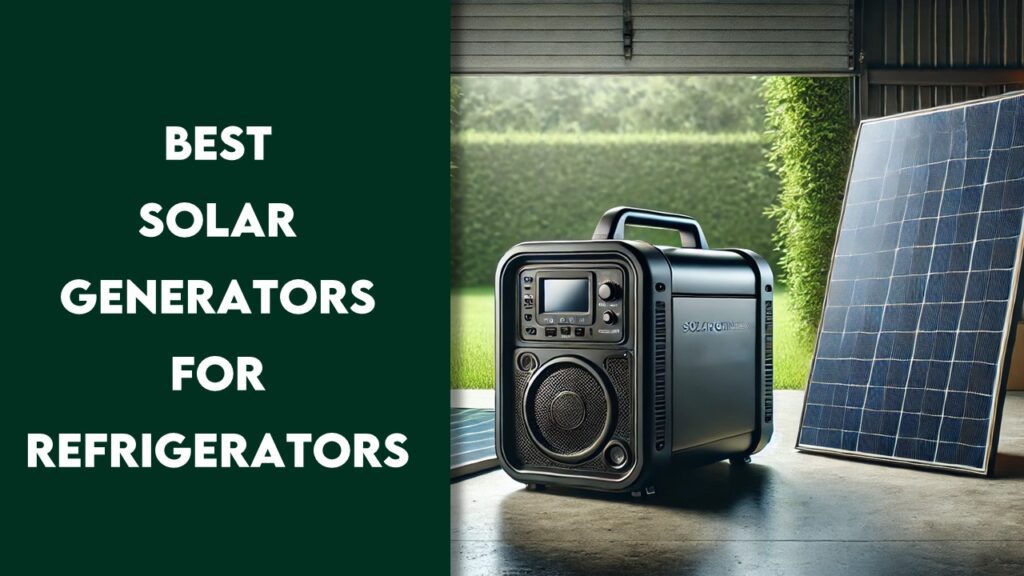Generator transfer switch kits are basically what let you safely and easily switch to generator power during an outage without any hassle. In this guide, we have extensively researched, reviewed, and ranked the 7 best generator transfer switch kits in 2025.
We’re reader-supported. When you buy through links on our site, we may earn an affiliate commission. As an Amazon Associate, we earn from qualifying purchases.
Our Top 7 Picks of The Best Generator Transfer Switch Kits
1. Best Overall Option: Reliance Controls Corporation 31406CWK
2. Best Heavy-Duty Option: Generac RXSW200A3
3. Fast Installation Option: Reliance Controls 31410CRK Pro/Tran
4. Manual Option: Generac 9854 HomeLink
5. Outdoor Option: wriboard Upgraded 30 Amp 6 Circuit Transfer Switch Kit
6. Versatile Usage Option: Connecticut Electric EmerGen Transfer Switch Kit
7. Budget Option: MUJURUR 100A Generator Transfer Switch
What Is The Best Generator Transfer Switch Kit In 2025?
Finding the best generator transfer switch kit can feel overwhelming. With so many options out there, it’s hard to know where to start. Moreover, you want something reliable, safe, and easy to install. Here is a carefully curated list of the best kits for 2025:
1. Best Overall Option: Reliance Controls Corporation 31406CWK
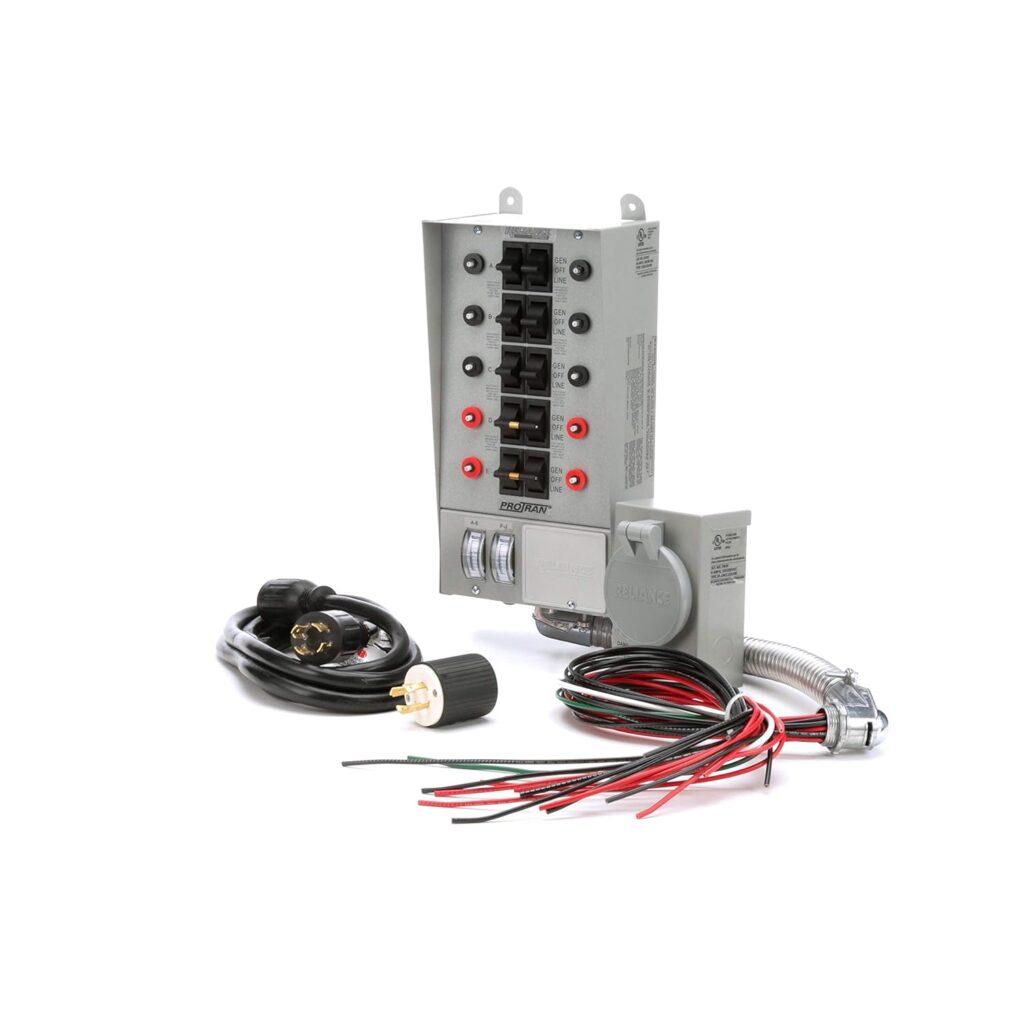
Key Specifications
- Brand: Reliance Controls
- Current Rating: 30 Amps
- Operating Voltage: 250 Volts (AC)
- Circuit Type: 6-way
- Switch Type: Toggle
- Mounting Type: Panel Mount
- Power Source: Corded-Electric
- Material: Alloy Steel
- Dimensions: 4.5 x 7 x 7.5 inches
- Control Method: Remote
- Connector Type: Plug In
From our standpoint, the Reliance Controls 31406CWK is a solid choice for anyone looking for a well-built and easy-to-install generator transfer switch kit. It’s a 30-amp, six-circuit switch that works well for mid-sized generators, making it a good fit for most homes. It’s built with alloy steel, which gives it a sturdy feel, and the panel mount design makes it simple to install. If you’re running a 7500-watt generator, this kit gives you a safe way to hook up essential appliances without dealing with multiple extension cords.
In our view, one of the best things about this transfer switch kit for generators is how straightforward it is. The push-button actuator makes operation smooth, and the toggle switch design keeps things simple. You don’t need to mess with complicated settings—it does exactly what it’s supposed to do. From a usability standpoint, it’s a practical and well-thought-out option for anyone who wants a dependable manual transfer switch.
Pros
- Easy to install with everything included in the kit
- Provides a reliable power transfer for essential home circuits
- Compact design that doesn’t take up much space
- Strong and durable alloy steel construction
Cons
- Limited to six circuits, so it may not be enough for bigger homes
- Requires manual operation, which might not suit those preferring an automatic transfer switch
From our perspective, the Reliance Controls 31406CWK is a practical and dependable choice for those who need a manual transfer switch kit for their generator. It’s simple to operate, built to last, and doesn’t overcomplicate things. While it doesn’t have automatic switching, it does its job well and provides a safe, efficient way to connect your generator to your home’s electrical system. If you’re looking for a reliable transfer switch kit that gets the job done without unnecessary complexity, this is a proper option to consider.
2. Best Heavy-Duty Option: Generac RXSW200A3

Key Specifications
- Brand: Generac
- Current Rating: 200 Amps
- Operating Voltage: 240 Volts
- Circuit Type: 3-way
- Switch Type: Automatic
- Mounting Type: Panel Mount
- Power Source: Generator-Powered
- Material: Aluminum
- Dimensions: 6.3 x 13.5 x 30 inches
- Control Method: App
- Connector Type: Screw or Blade
From our perspective, the Generac RXSW200A3 is a solid option for those who need a heavy-duty generator transfer switch kit that can handle higher power loads. It’s designed for single-phase generators, making it a great fit for larger homes or businesses. What stands out is its automatic operation, which ensures a smooth switch from utility power to generator power without needing any manual intervention.
In our opinion, another strong feature is its advanced digital power management (DPM), which helps regulate up to four HVAC loads efficiently. This makes it a practical option for households with multiple power-intensive appliances. The NEMA 3R outdoor-rated aluminum enclosure adds durability, making it a great choice for both indoor and outdoor setups.
Pros
- Handles high power loads with a 200-amp capacity, making it ideal for large homes.
- Seamless automatic switching ensures power transitions without manual effort.
- Weather-resistant aluminum enclosure provides durability for outdoor installations.
- Smart power management improves efficiency by prioritizing key circuits.
Cons
- Larger size might require more space for installation.
- Professional installation recommended, which may add to the overall cost.
From our standpoint, the Generac RXSW200A3 stands out as a proper choice for those who need a reliable and high-capacity automatic transfer switch kit. The seamless power transition, sturdy build, and smart load management make it a strong option for homes and businesses that require uninterrupted power. While it may take some effort to install, the long-term reliability and ease of operation make it well worth considering.
3. Fast Installation Option: Reliance Controls 31410CRK Pro/Tran
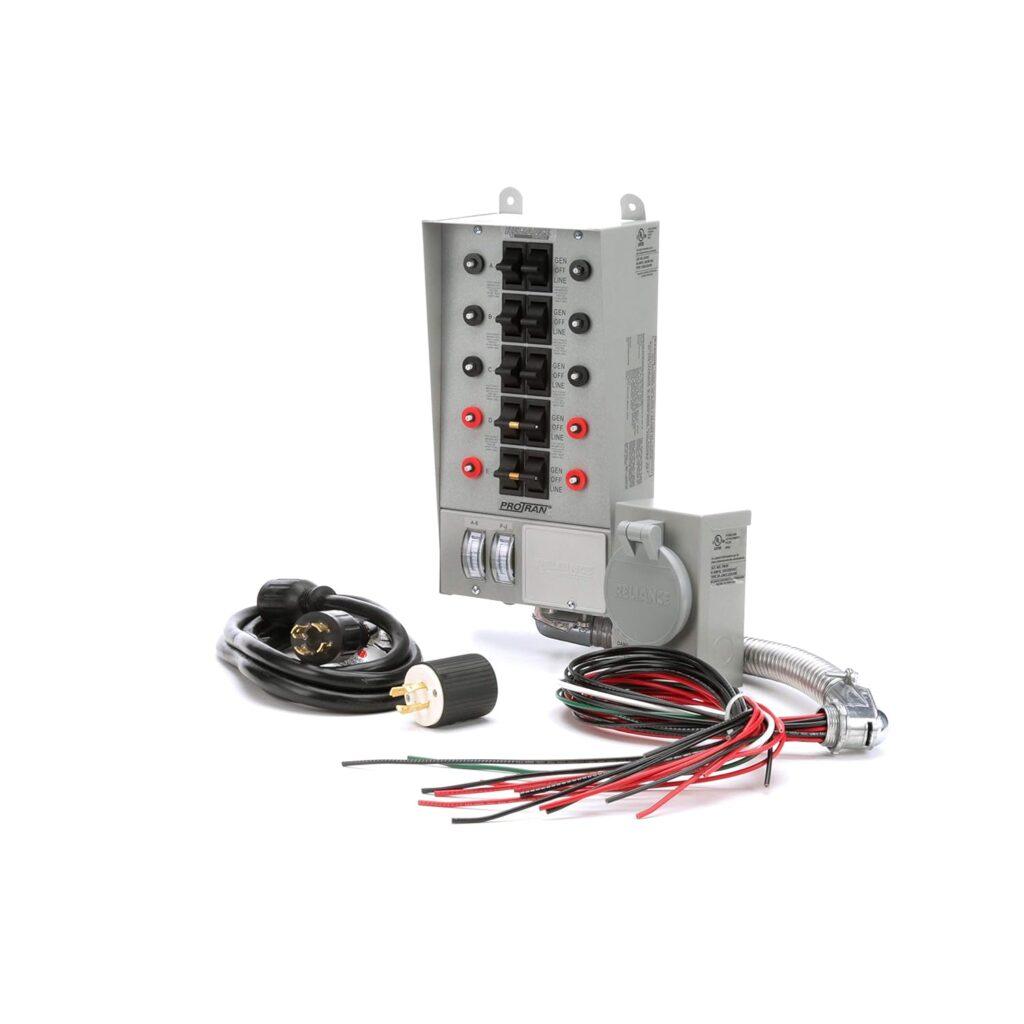
Key Specifications
- Brand: Reliance Controls
- Current Rating: 30 Amps
- Operating Voltage: 120 Volts (AC)
- Circuit Type: 2-way
- Switch Type: Toggle
- Mounting Type: Surface Mount
- Power Source: Generator-Powered
- Material: Copper
- Dimensions: 7 x 4.5 x 13.75 inches
- Control Method: Remote
- Connector Type: Plug In
From our perspective, the Reliance Controls 31410CRK Pro/Tran stands out for how quick and easy it is to install. The pre-wired design and 18-inch flexible conduit whip make the setup process much smoother, which is great for those who want a no-fuss installation. It’s designed for generators up to 7,500 watts, making it a suitable choice for homes or small businesses that need a reliable manual transfer switch without the complexities of an automatic system.
In our opinion, the 10-circuit capacity is a great feature, allowing users to power multiple essential appliances at once. The copper construction adds to its durability, and the rugged powder-coated steel cabinet gives it a sturdy, long-lasting feel. It’s a practical option for anyone looking for a straightforward and efficient way to connect their generator to their home’s electrical system.
Pros
- Easy and quick installation, making it ideal for homeowners with limited experience.
- Supports up to 10 circuits, allowing for flexible power management.
- Durable copper construction, ensuring long-term reliability.
- Compact surface mount design, saving space while keeping it accessible.
Cons
- Manual switching required, which may not be ideal for those preferring automatic options.
- Limited to 120 volts, which may not support larger power needs.
From our standpoint, the Reliance Controls 31410CRK Pro/Tran is a solid pick for those who prioritize fast installation and ease of use. The pre-wired design, compact size, and sturdy build make it a practical choice for homeowners who want a hassle-free way to manage generator power. While it doesn’t have automatic switching, it delivers dependable performance and gets the job done efficiently.
4. Manual Option: Generac 9854 HomeLink
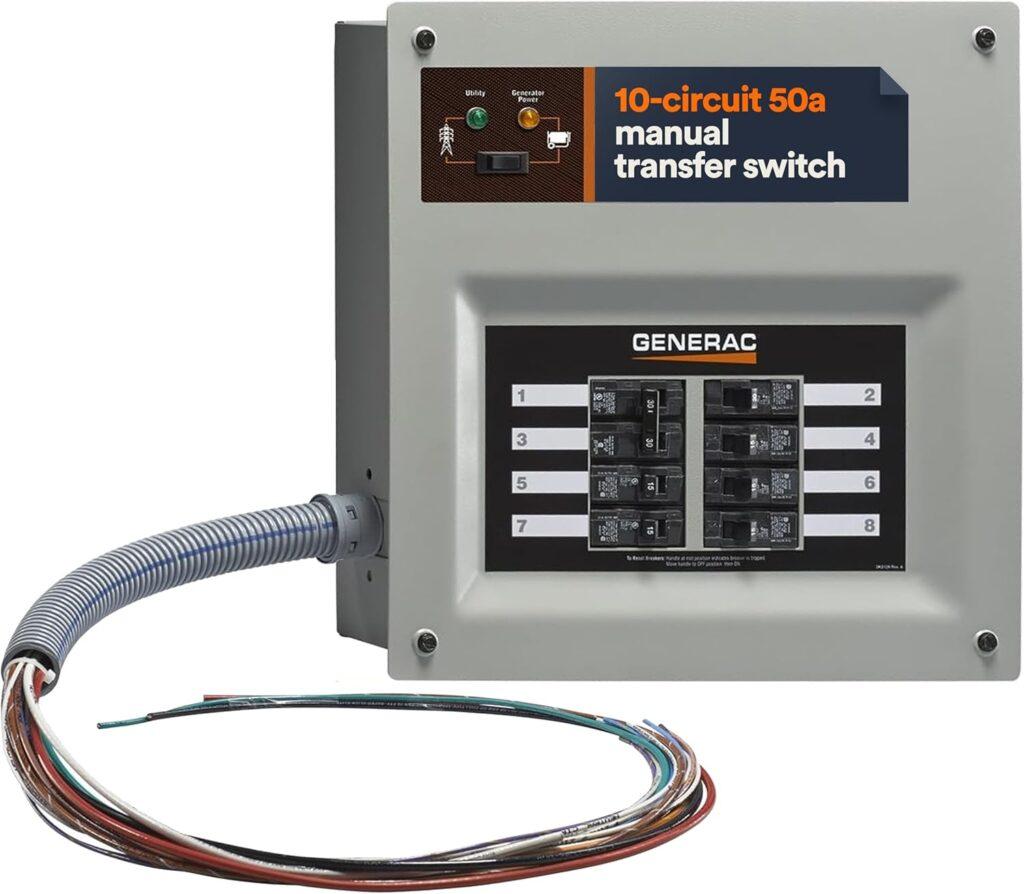
Key Specifications
- Brand: Generac
- Current Rating: 50 Amps
- Operating Voltage: 240 Volts
- Circuit Type: Upgradeable (8 to 16 Circuits)
- Switch Type: Manual
- Mounting Type: Surface Mount
- Power Source: Generator-Powered
- Material: Steel
- Dimensions: 26 lbs, compact design
- Control Method: Rocker Switch
- Connector Type: Plug-In
From our standpoint, the Generac 9854 HomeLink is a well-rounded manual transfer switch kit that keeps things simple and efficient. It’s designed to work with portable generators, allowing homeowners to power essential circuits during an outage. One thing we appreciate is how it comes pre-wired, making installation much more straightforward than some other models. For those who prefer hands-on control, this kit offers smooth switching between generator and utility power with a rocker-style button.
In our opinion, the upgradeability of this model is a major plus. Unlike most manual transfer switch kits for generators, this one can be upgraded to automatic functionality if paired with a compatible Generac standby generator. That flexibility makes it a practical long-term choice, especially for those who may want to transition from portable power to a fully automated backup system in the future.
Pros
- Pre-wired design makes installation faster and less complicated.
- Expandable circuit capacity from 8 to 16 circuits for future power needs.
- Easy-to-use rocker switch ensures a smooth manual transition between power sources.
- Indicator lights provide clear visibility of power status at all times.
Cons
- Manual operation required, which may not suit those looking for a fully automatic solution.
- Limited to Generac-compatible generators for optimal performance.
From our perspective, the Generac 9854 HomeLink is a proper option for homeowners looking for a manual transfer switch kit that is easy to use, well-built, and upgradeable. It offers reliable performance with a straightforward installation process, making it a smart choice for those who want manual control now but may consider automation later. While it requires manual operation, its solid build and smart design make it a practical and future-proof investment.
5. Outdoor Option: wriboard Upgraded 30 Amp 6 Circuit Transfer Switch Kit
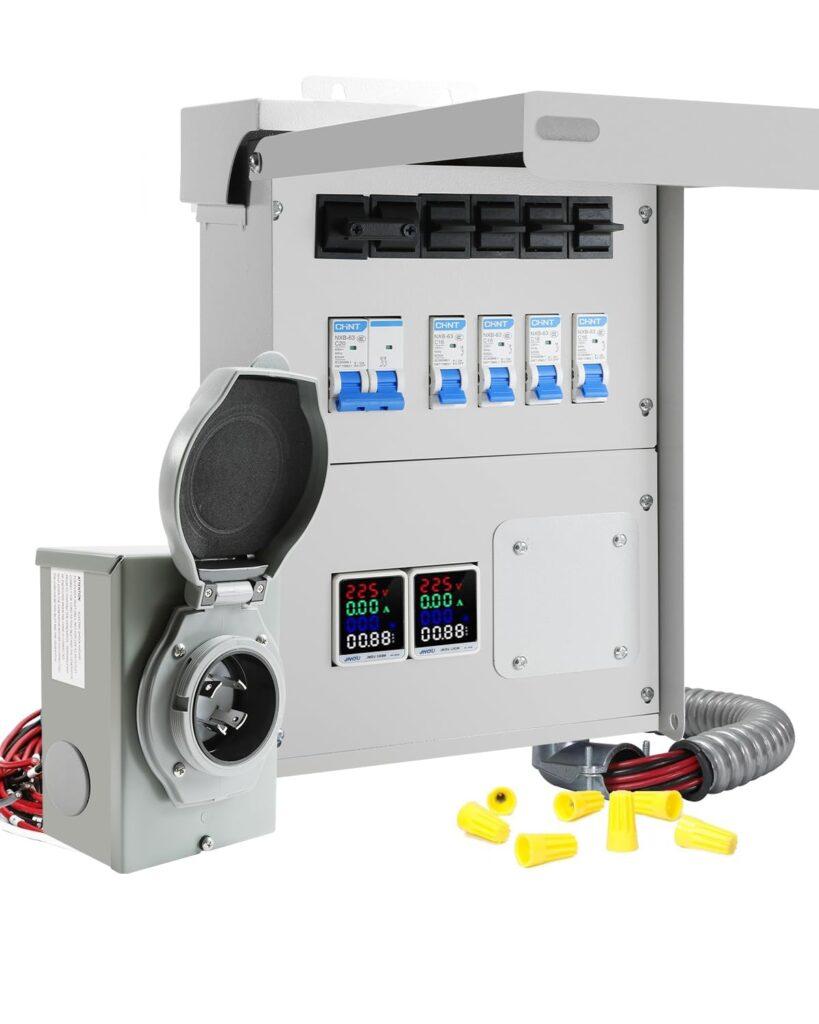
Key Specifications
- Brand: wriboard
- Current Rating: 30 Amps
- Operating Voltage: 120/240 Volts
- Circuit Type: 6-way
- Switch Type: Manual
- Mounting Type: Surface Mount
- Power Source: Generator-Powered
- Material: Polyester, Galvanized Steel, Iron
- Dimensions: Compact and Outdoor-Rated
- Control Method: Manual Switch with Digital Display
- Connector Type: NEMA L14-30P
From our standpoint, the wriboard Upgraded 30 Amp 6 Circuit Transfer Switch Kit is a solid choice for those looking for a rugged outdoor-ready transfer switch kit for generators. The NEMA 3R housing and IP67 waterproof rating make it a reliable option for withstanding harsh weather conditions. It comes pre-wired, making installation straightforward, which is great for homeowners who want a simple setup.
One feature that stands out in our view is the digital display energy meter. Unlike most manual transfer switches, this one allows users to monitor voltage, wattage, and power usage in real time. It adds an extra level of convenience, making it easy to track energy consumption and optimize power use. If weather resistance, durability, and real-time monitoring are priorities, this transfer switch kit brings a lot to the table.
Pros
- Weatherproof and durable, built for both indoor and outdoor use.
- Pre-wired design, making installation faster and more convenient.
- Digital display meter, allowing users to monitor power consumption easily.
- Compact and efficient, saving space while providing reliable performance.
Cons
- Manual operation, which may not suit those preferring an automatic transfer switch.
- Limited to 6 circuits, which may not be enough for homes with higher power needs.
From our perspective, the wriboard Upgraded 30 Amp 6 Circuit Transfer Switch Kit is a proper choice for anyone needing a reliable outdoor transfer switch kit. The weatherproof construction, digital energy monitoring, and pre-wired design make it a practical and user-friendly option. While it doesn’t have automatic switching, it delivers efficient performance and is built to handle outdoor conditions with ease.
6. Versatile Usage Option: Connecticut Electric EmerGen Transfer Switch Kit

Key Specifications
- Brand: Connecticut Electric
- Current Rating: 30 Amps
- Operating Voltage: 240 Volts
- Circuit Type: 1-way
- Switch Type: Rocker
- Mounting Type: Panel Mount
- Power Source: Generator-Powered
- Material: Alloy Steel
- Dimensions: 11.5 x 20.5 x 14.5 inches
- Control Method: Touch
- Connector Type: Plug In
From our standpoint, the Connecticut Electric EmerGen Transfer Switch Kit is a practical choice for those who need flexibility in managing backup power. It works with portable generators up to 7,500 watts, making it a solid fit for homes needing a safe and organized way to power essential circuits. One standout feature is its double-throw rocker switches, which prevent backfeeding, adding an extra layer of safety and reliability.
In our opinion, the indoor and outdoor compatibility makes it a great option for different setups. The NEMA 3R rainproof rating means it can withstand outdoor conditions, while its panel mount design allows for a clean and secure installation. The ability to use 240-volt circuits or convert them to single-pole circuits gives users more control over power distribution, which is not something every transfer switch offers.
Pros
- Compatible with all major load centers, making installation easier.
- Indoor and outdoor use, providing flexibility in placement.
- Prevents backfeeding, ensuring safe operation during power outages.
- Supports both 240V and 120V circuits, offering versatile power distribution.
Cons
- Slightly larger size, which may require more installation space.
- Manual switching required, so it doesn’t automatically transfer power.
From our perspective, the Connecticut Electric EmerGen Transfer Switch Kit is a proper option for those who need versatility and reliability in a manual transfer switch. The compatibility with different load centers, indoor/outdoor design, and safe power transfer features make it a well-rounded choice. While it requires manual operation, it delivers dependable performance and is built to handle different power needs effectively.
7. Budget Option: MUJURUR 100A Generator Transfer Switch
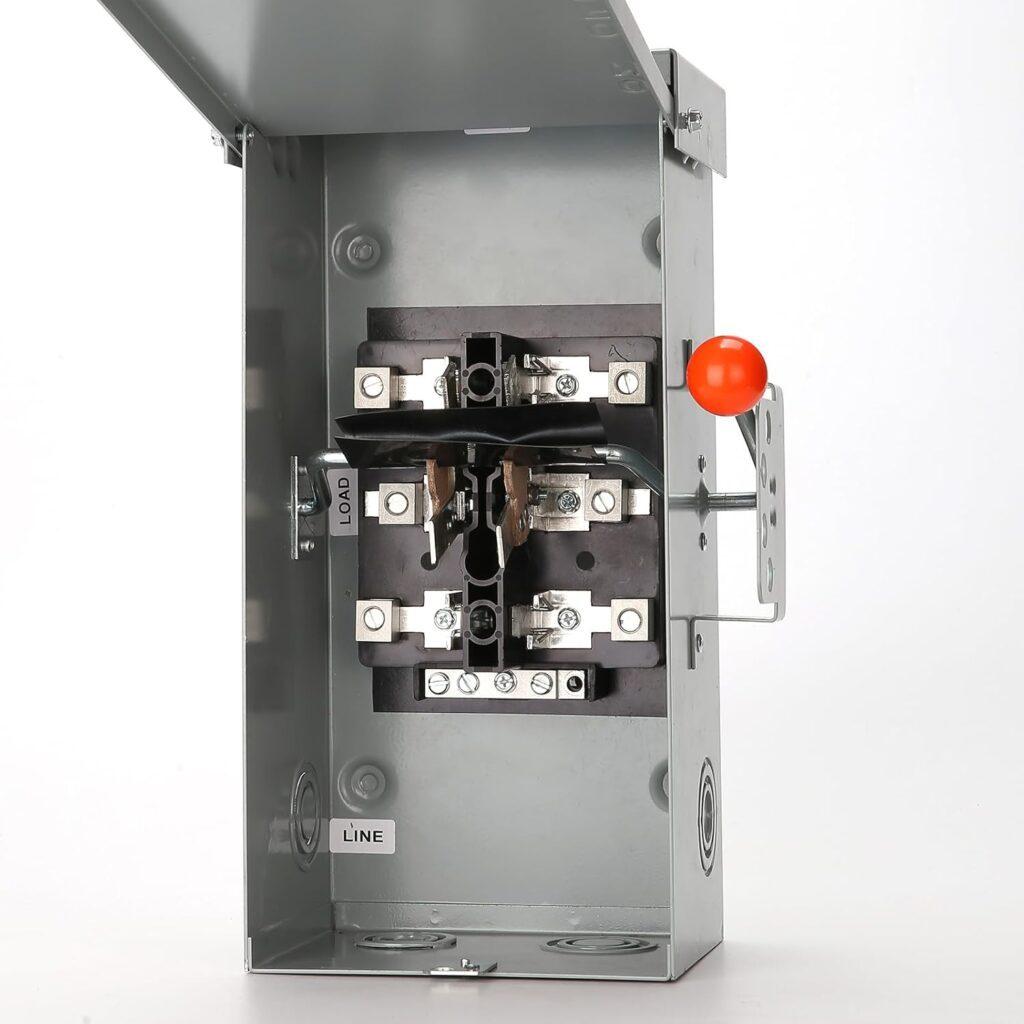
Key Specifications
- Brand: MUJURUR
- Current Rating: 100 Amps
- Operating Voltage: 120/240 Volts
- Circuit Type: Double-Throw
- Switch Type: Manual
- Mounting Type: Wall Mount
- Power Source: Generator-Powered
- Material: Galvanized Steel
- Dimensions: Compact and Weather-Resistant
- Control Method: Manual Lever
- Connector Type: Standard Wiring
From our standpoint, the MUJURUR 100A Generator Transfer Switch is a practical choice for those looking for an affordable yet capable manual transfer switch. It offers 100 amps of capacity, making it suitable for homes with higher power demands, including heavy appliances like dryers and stoves. The double-throw lever design ensures a smooth transition between utility and generator power without unnecessary complexity.
In our opinion, the galvanized steel casing and NEMA 3R rating make it a reliable option for outdoor and indoor use. The simple, electronics-free design means there’s less risk of failures due to moisture or dust, which is common in electronic-based switches. For those who want a stable, long-term backup power solution, this model brings a lot to the table at a budget-friendly price.
Pros
- Solid 100-amp capacity, making it suitable for high-demand households.
- Heavy-duty galvanized steel construction, ensuring durability in outdoor conditions.
- Manual double-throw switch, reducing risks of electronic failures.
- Straightforward installation, with clear instructions included.
Cons
- Manual operation only, which may not be ideal for those wanting an automatic transfer switch.
- Larger size, requiring more space for installation.
From our perspective, the MUJURUR 100A Generator Transfer Switch is a proper choice for anyone seeking a cost-effective and sturdy manual transfer switch. Its high amp capacity, weatherproof design, and simple operation make it a reliable backup power solution for both indoor and outdoor use. While it requires manual switching, it delivers stable performance and long-term dependability at a reasonable price point.
How the Generator Transfer Switch Kits Were Tested
The best generator transfer switch kits are identified through a combination of real-world testing, expert evaluations, and user feedback. Customer reviews, forums, and ratings are invaluable for understanding long-term reliability and common concerns.
Key Factors Considered in Testing:
- Ease of Installation: Focused on how user-friendly the setup was, including clear instructions and the availability of necessary tools.
- Switching Performance: Checked how smoothly and quickly the switch transitioned between the grid and generator.
- Durability: Assessed the quality of materials and weatherproofing for indoor and outdoor conditions.
- Safety Features: Evaluated features like backfeeding prevention, surge protection, and overload safety.
- Compatibility: Tested with various generator types, including portable, standby, and inverter models, to ensure versatile functionality.
- Customer Feedback: Analyzed real user experiences through reviews and forums to identify patterns in satisfaction and recurring issues.
In addition to practical testing, insights from homeowners and electricians provided a balanced view of what works in real-life scenarios.
This comprehensive process highlights transfer switch kits that excel in performance, safety, and user satisfaction. Reviews and forums offer valuable perspectives, helping identify options that stand out for both reliability and ease of use.
What Are Generator Transfer Switch Kits?
Generator transfer switch kits are the tools that connect your generator to your home’s electrical panel safely. They let you control which circuits in your home get power during an outage without needing multiple extension cords. This makes them a practical and much safer solution when compared to other methods of using a generator.
These kits include a switch that “transfers” the power source from the utility grid to your generator. With a quick flip of a switch, you can keep critical appliances like your fridge, lights, or even HVAC running smoothly during a power outage. It’s the kind of convenience and safety you can rely on when you need it most.
Transfer switch kits come in different types, like manual or automatic, and are designed to suit various generator sizes. Whether you’re powering a small home or a larger setup, there’s a transfer switch kit that fits your needs perfectly.
Why Are Generator Transfer Switch Kits Necessary?
Powering your home during an outage without a transfer switch can be risky and frustrating. Transfer switch kits solve this by making the process safer, easier, and more efficient.
Here’s why they’re necessary:
- Prevent Backfeeding: They stop electricity from flowing back into the grid, protecting utility workers.
- Safer Connections: They eliminate the need for messy and dangerous extension cords.
- More Convenient: With a transfer switch, you can control which circuits are powered.
- Meet Electrical Codes: Many areas require transfer switches to comply with safety regulations.
Without a transfer switch, managing power during an outage can feel chaotic. These kits simplify everything, giving you peace of mind when you need it most.
What Are the Types of Generator Transfer Switch Kits?
There are three main types of generator transfer switch kits, and each is designed for a specific kind of use. Choosing the right one depends on your generator, the power you need, and how you plan to use it. Let’s break them down so you can see which one fits your situation.
Manual Transfer Switch Kits
Manual transfer switch kits are the most basic option. As the name suggests, you’ll need to manually flip the switch when there’s an outage to transfer power from the grid to your generator. These kits are simple and affordable, making them a popular choice for small setups or people who don’t mind a little extra work.
Key Benefits of Manual Transfer Switch Kits:
- Cost-Effective: They’re easy on your wallet compared to more advanced options.
- Straightforward Installation: No need for complicated wiring or additional equipment.
- Full Control: You get to decide which circuits get power during an outage.
Manual kits are great if you’re okay with being around to handle things when the power goes out. However, they require you to take action every time, so they’re not ideal if you’re away or asleep when an outage hits.
Automatic Transfer Switch Kits
Automatic transfer switch kits take the hassle out of switching. They do the work for you, flipping over to generator power the moment an outage is detected. These kits are perfect for homes or businesses where constant power is essential, like keeping medical equipment or appliances running.
Key Benefits of Automatic Transfer Switch Kits:
- Hands-Free Operation: No need to be present when the power goes out.
- Reliable for Critical Loads: Great for things like sump pumps or HVAC systems.
- Seamless Transition: You may not even notice the power went out.
If you want peace of mind and convenience, automatic kits are the way to go. They’re more expensive upfront but are worth it for anyone who needs reliable, hands-off power backup.
Portable Generator Transfer Switch Kits
Portable generator transfer switch kits are designed for temporary use with portable generators. These kits are highly flexible and work well for homes, RVs, or outdoor activities like camping or tailgating. They’re also a solid option for people who don’t want to commit to a permanent installation.
Key Benefits of Portable Generator Transfer Switch Kits:
- Versatile: Perfect for on-the-go power needs or emergency use.
- Quick Setup: Easy to connect when you need it, no complex installation.
- Budget-Friendly: A more affordable solution for occasional use.
These kits are perfect for anyone who doesn’t need a permanent system. Just pair them with your portable generator, and you’re ready to go, whether it’s powering your home or your RV.
Key Features to Consider When Buying the Best Generator Transfer Switch Kit
When choosing a generator transfer switch kit, understanding the key features is essential to get the right match for your needs. A good transfer switch is not just about functionality; it ensures safety, convenience, and seamless operation when switching power sources.
Let’s dive deeper into the most important considerations to help you make an informed decision.
Determining Power Requirements
One of the first things to figure out is how much power you’ll need during an outage. This is critical because choosing a switch with the wrong capacity can lead to inefficiency or even damage to your system.
To calculate, start by listing every appliance or device you plan to power. Each will have a wattage or amperage rating, and here’s how you can calculate the total power:
Formula: Watts = Volts × Amps
For example, a refrigerator running at 120 volts and using 6 amps will require: 120 × 6 = 720 watts.
Add in a 1,500-watt space heater and a 1,000-watt microwave: 720 + 1,500 + 1,000 = 3,220 watts.
Always choose a transfer switch with a wattage capacity slightly higher than your calculated total. For this example, a switch rated for at least 4,000 watts would give you enough headroom to avoid overloading. This calculation helps you avoid the frustration of running out of power during an emergency and ensures your generator works efficiently with the switch.
Matching Your Generator Type
Not all generators work with every type of transfer switch. Ensuring compatibility is essential to avoid installation headaches or performance issues. Here’s a quick guide to match your generator type:
- Inverter Generators: These produce clean energy and often require switches that can handle variable wattage outputs. Look for compatibility labels when purchasing.
- Standby Generators: Typically paired with automatic transfer switches. These generators are stationary and designed for seamless power switching during outages.
- Portable Generators: Best suited for manual or portable transfer switches. These setups are flexible for temporary or emergency use.
Matching the switch to your generator ensures smooth operation and extends the life of both devices.
Features You Should Consider
Every transfer switch kit has different features, but some stand out more depending on your needs. The right features can make a big difference in usability and safety.
Key Features to Look For:
- Surge Protection: Prevents appliances from being damaged by power spikes.
- Weatherproof Design: Ideal if the switch will be installed outdoors.
- Load Balancing: Ensures even distribution of power to avoid overloading circuits.
- Indicator Lights: Helps you quickly identify whether utility or generator power is active.
- Circuit Support: Choose a switch with enough circuits to cover all your essential appliances.
Investing in a transfer switch with these features adds safety and reliability to your system. While they may increase the cost, they’re worth it in the long run to ensure your setup operates smoothly during emergencies.
Single-Phase vs. Three-Phase Transfer Switch Kits
The choice between single-phase and three-phase transfer switches comes down to your electrical setup. These terms might sound technical, but they’re just different ways of distributing power.
Here’s a quick breakdown:
| Feature | Single-Phase | Three-Phase |
| Use Case | Homes, small businesses | Large buildings, industrial facilities |
| Power Distribution | One phase of power | Three alternating phases of power |
| Equipment Compatibility | Standard appliances | Heavy machinery, high-power equipment |
| Cost | Generally more affordable | Higher due to increased capacity |
If you’re powering a home or a small office, single-phase is usually all you need. It’s designed for typical household appliances like refrigerators, lights, and small HVAC systems. On the other hand, three-phase systems are ideal for businesses or industrial setups that run heavy equipment.
How to Install a Generator Transfer Switch Kit
Installing a generator transfer switch kit can be done on your own if you’re confident in handling electrical work. However, it’s crucial to exercise caution, follow local codes, and consider professional guidance if you’re unsure. Electrical installations can be risky, so if in doubt, always consult an expert.
DIY Installation: What You Need to Know
DIY installation of a transfer switch is manageable with the right tools and preparation, but it’s not something to take lightly. Working with electricity carries risks, so proceed with care.
Note: We are not licensed electricians. Always seek professional supervision if you’re not confident in completing the work yourself.
Steps to Install a Generator Transfer Switch Kit:
- Turn Off Power to Your Home: Shut off the main breaker in your electrical panel to ensure safety.
- Select Circuits to Be Powered: Choose the most essential circuits that will receive generator power during an outage.
- Mount the Transfer Switch: Secure the switch next to your main electrical panel.
- Connect the Wiring: Match the wires from the transfer switch to their corresponding circuits in the panel.
- Install the Power Inlet Box: Mount the box outside your home and connect it to the transfer switch.
- Test the System: Plug in the generator, turn it on, and test each circuit to make sure it works correctly.
Installing a transfer switch yourself can save money, but it’s essential to double-check every step. If you’re unsure at any stage, calling a professional is always the safest option.
Hiring a Professional Electrician
Hiring a licensed electrician is often the smartest way to install a transfer switch. Professionals have the expertise to ensure the installation is safe, compliant with local codes, and tailored to your home’s needs. They’ll handle everything from wiring to testing, minimizing the risk of mistakes or safety hazards. While it may cost more upfront, this option gives you peace of mind, knowing your setup is reliable and properly installed.
Tools and Materials Required for Installation
Before starting, gather all the tools and materials needed for the installation. Proper preparation helps the process go smoothly and minimizes unnecessary delays.
Tools and Materials Needed:
| Tool/Material | Purpose |
| Transfer Switch Kit | The main component to connect your generator to the electrical panel. |
| Power Inlet Box | Provides an outdoor connection point for the generator. |
| Circuit Breakers | For additional circuit protection. |
| Electrical Wires & Connectors | To connect the transfer switch to the panel and generator. |
| Drill & Mounting Screws | For mounting the transfer switch and power inlet box. |
| Screwdrivers (Flathead & Phillips) | For attaching and securing wires. |
| Wire Strippers & Cutters | To prepare and trim wires for connections. |
| Voltage Tester | Ensures circuits are not live during installation. |
| Safety Gloves & Goggles | Protects you from electrical hazards and debris. |
Having these tools and materials ready can save time and make the process much safer. If you don’t own some of these, they’re widely available at hardware stores. Always double-check your list before starting.
What Can You Power Using a Transfer Switch?
A transfer switch gives you the flexibility to control which appliances and systems are powered during an outage. Whether it’s essential household appliances or equipment for outdoor or business use, a transfer switch ensures everything runs smoothly.
Household Essentials
Here are common household items you can power using a transfer switch:
| Appliance/System | Why It’s Important |
| Refrigerator/Freezer | Keeps food from spoiling during long outages. |
| HVAC System or Space Heater | Maintains comfort by controlling indoor temperatures. |
| Water Heater | Ensures access to hot water for hygiene and cleaning. |
| Sump Pump | Prevents flooding in basements or low-lying areas. |
| Lighting Circuits | Keeps key rooms lit during an outage. |
| Microwave/Kitchen Appliances | Allows you to prepare meals without interruption. |
| Washer/Dryer | Ensures you can do laundry when needed. |
Powering these essentials ensures that your household remains functional and comfortable, even during extended outages.
RVs and Outdoor Events
Transfer switch kits are also widely used for mobile power needs. Whether in an RV or at an outdoor event, they let you seamlessly switch between generator and grid power.
| Use Case | What It Powers |
| RVs | Fridge, air conditioner, lights, and small appliances. |
| Camping/Outdoor Events | Portable lights, fans, speakers, and charging devices. |
This flexibility makes transfer switches an excellent choice for anyone who needs reliable power on the go.
Small Business Applications
Small businesses can’t afford to lose power for long periods, and transfer switches are a lifesaver in these situations. They help keep critical operations running smoothly during an outage.
| Business Type | What It Powers |
| Retail Stores | Cash registers, lighting, and security systems. |
| Small Offices | Computers, routers, and phone systems. |
| Restaurants or Cafes | Refrigeration, cooking equipment, and point-of-sale systems. |
| Workshops | Power tools and essential machinery. |
For businesses, a transfer switch ensures that downtime is minimized, protecting revenue and customer trust during outages.
Troubleshooting and Maintenance Tips for Transfer Switch Kits
Proper maintenance and troubleshooting of your generator transfer switch kit ensure it works reliably during power outages. Keeping the system in top shape reduces the chances of failure when you need it most.
Regular Maintenance Checklist
Regular maintenance is key to the longevity of your transfer switch kit. Here’s how often and what you should check:
- Monthly: Test the transfer switch by running the generator and ensuring it switches power smoothly.
- Quarterly: Inspect all wiring and connections for wear, corrosion, or looseness. Tighten any loose connections.
- Annually: Clean the transfer switch enclosure to remove dust and debris. Check the overall functionality of the system by simulating a power outage.
Consistent maintenance prevents unexpected failures and ensures the system operates efficiently during an emergency.
Common Problems and How to Fix Them
Even with regular maintenance, you may encounter common issues with transfer switch kits. Here’s how to troubleshoot them:
- Faulty Switching: If the transfer switch doesn’t engage or disengage properly, check the wiring and ensure all connections are secure.
- Power Surges: Surges during switching could indicate damaged surge protectors or improper grounding. Replace damaged components and verify the ground connection.
- Generator Not Connecting: If the generator isn’t transferring power, inspect the power inlet box and generator connection for issues. Ensure the generator’s power output matches the switch’s rating.
- Burnt Smell or Heat: If you notice overheating, it may indicate overloaded circuits. Reduce the load or upgrade to a higher-capacity transfer switch.
If these issues persist, it’s best to consult a licensed electrician for a thorough inspection.
How Much Does a Generator Transfer Switch Kit Cost?
The cost of a generator transfer switch kit depends on several factors, including its size, features, and brand. Understanding these variables can help you find the right kit within your budget.
Factors That Influence Pricing
Here are the main factors that impact the cost of a transfer switch kit:
- Size (Amperage): Larger kits that handle higher amperage (e.g., 200 amps) cost more than smaller ones (e.g., 50 amps).
- Features: Kits with advanced features like automatic switching, surge protection, or load balancing are more expensive.
- Brand: Well-known brands like Generac, Eaton, and Siemens often charge more for reliability and warranty coverage.
- Type of Installation: Outdoor-rated switches or weatherproof enclosures typically add to the cost.
For example, a basic manual transfer switch kit for a small home may cost $200–$400, while an automatic switch for a large standby generator can range from $500–$2,000 or more.
Comparing Manual vs. Automatic Kits
Manual and automatic transfer switch kits vary significantly in both cost and functionality. Here’s how they compare:
| Feature | Manual Kits | Automatic Kits |
| Cost | $200–$600 | $500–$2,000+ |
| Operation | Requires manual flipping of the switch | Automatically switches during outages |
| Convenience | Hands-on control | Hands-free operation |
| Use Case | Small setups or temporary power needs | Larger homes or critical power loads |
Are Automatic Kits Worth It?
If convenience and seamless operation are your priority, automatic kits are worth the higher price. They’re ideal for people who want a hands-off solution or need to power essential equipment like medical devices. Manual kits, however, are a cost-effective choice for smaller setups or those who don’t mind being actively involved during an outage.
By weighing these factors, you can decide which type of transfer switch fits your needs and budget.
Wrapping It Up!
Generator transfer switch kits are essential tools that make powering your home or business during outages safer, easier, and more efficient. They allow seamless switching between utility power and your generator, eliminating the need for messy extension cords and reducing safety risks.
Choosing the right transfer switch depends on your power needs, generator type, and the features you prioritize. Whether it’s a manual, automatic, or portable kit, understanding your requirements and selecting a compatible option ensures reliable performance during emergencies.
Proper installation and regular maintenance are critical to keeping your system safe and functional. Always prioritize safety by following local codes and consulting a professional electrician if you’re unsure. A well-installed and maintained transfer switch will serve you reliably for years.
Related FAQs
Why do I need a transfer switch for my generator?
A transfer switch safely connects your generator to your home’s electrical system, preventing backfeeding and allowing you to power circuits directly without extension cords.
Can I install a transfer switch myself?
Yes, but it depends on your electrical skills. DIY installation is possible for those comfortable with wiring, but hiring a licensed electrician is recommended for safety and compliance.
How do I know which size transfer switch to choose?
Calculate the total wattage of the appliances you want to power during an outage. Choose a transfer switch rated slightly higher than your total wattage to avoid overloading.
What happens if I don’t use a transfer switch?
Without a transfer switch, backfeeding can occur, posing serious risks to utility workers and your electrical system. It’s also unsafe and non-compliant with electrical codes.
Is a transfer switch compatible with solar generators?
Yes, many transfer switches are compatible with solar generators, but it’s important to check compatibility for clean energy output and inverter systems.
At our core, we’re a group of passionate generator, inverter, solar energy, battery enthusiasts. We dive deep into the world of tech, especially when it’s about powering your home, RV or outdoors. We try to provide as much value to the readers with our information and how to blog articles as possible. For affiliate articles our honest and transparent reviews of essential tech products are rooted in real-world experience. We take great satisfaction in offering unbiased evaluations, ensuring that you can make informed decisions when investing in your desired techs.


